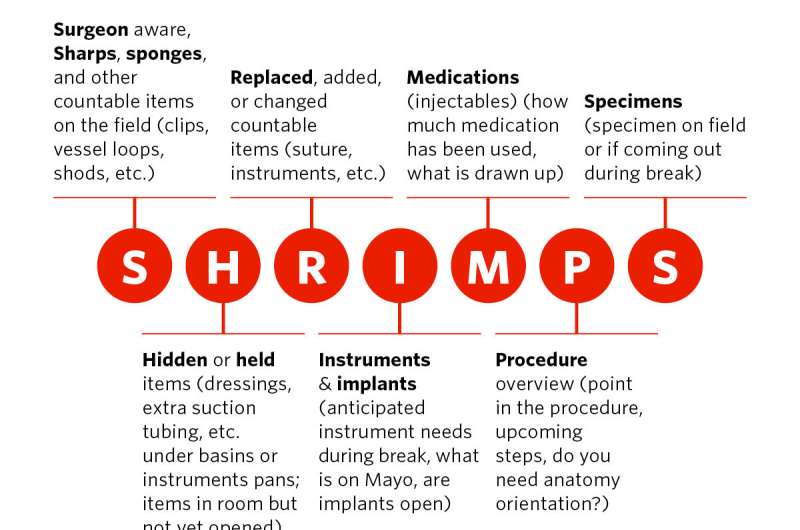This article has been reviewed according to Science X's editorial process and policies. Editors have highlighted the following attributes while ensuring the content's credibility:
fact-checked
peer-reviewed publication
trusted source
proofread
Standardized operating room handoffs significantly improve surgical communication and patient safety, study finds

A new study showcases a successful quality improvement program that significantly enhances surgical safety. By implementing a standardized handoff protocol, known as SHRIMPS, the study demonstrates how effective communication in operating rooms (OR) can reduce the risk of errors and improve patient care.
The findings are published in the Journal of the American College of Surgeons, in a paper titled "Surgical Intraoperative Handoff Initiative: Standardizing Operating Room Communication using SHRIMPS."
"This study is a prime example of how quality improvement initiatives can lead to better patient outcomes," said study co-author Madeline Anderson, DO, a surgery resident at the University of Kentucky. "By standardizing communication during surgical procedures, we can ensure that all team members are informed, and that critical information is consistently conveyed, reducing the risk of errors."
Prompted by a frontline stakeholder's concerns about inadequate quality surgical technician handoffs, the quality improvement (QI) team at the Lexington VA Medical Center, affiliated with the University of Kentucky hospital, developed an audit tool to evaluate handoffs across various surgical cases from May 2022 to February 2024. Initial audits revealed handoffs occurred in 82.6% of cases, but with only 34.4% of critical elements being communicated.
In response, the team, in collaboration with OR staff, developed a standardized communication checklist with the acronym "SHRIMPS" (Sharps, Sponges, Hidden or held items, Replaced items, Instruments & Implants, Medications, Procedure overview, Specimens).
Although it has nothing to do with the crustacean, the team chose the SHRIMPS acronym to be a helpful mnemonic device for surgical teams. This checklist was displayed prominently in all ORs at the Lexington VA Medical Center.
Key findings
- Before implementing SHRIMPS, handoffs occurred in 82.6% of cases, with only 34.4% of critical elements communicated.
- After implementing SHRIMPS, 100% of cases included handoffs, with 98.2% of critical elements addressed.
- The duration of handoffs averaged 69.4 seconds post-implementation, ensuring thorough communication without significantly increasing handoff time.
- Announcements of handoffs to the entire OR team increased to 97.1%, ensuring all staff were aware of personnel changes.
"Part of the success of SHRIMPS comes from the QI team engaging with both topline and frontline OR stakeholders, including surgical technicians and circulating nurses," said Dr. Anderson. "This approach ensures the tool is more effective and garners buy-in from the people ultimately using it."
The success of the SHRIMPS protocol highlights the significant impact quality improvement programs can have in health care—by implementing standardized handoff protocols, operating rooms can achieve better communication, fewer errors, and enhanced patient care, the authors note. The study authors advocate for the widespread adoption of such tools to ensure reliable and efficient information transfer in surgical environments.
More information: Surgical Intraoperative Handoff Initiative: Standardizing Operating Room Communication using SHRIMPS, Journal of the American College of Surgeons (2024). DOI: 10.1097/XCS.0000000000001115




















